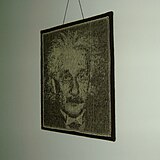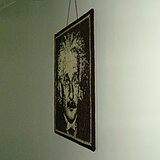Crochet is a process of creating textiles by using a crochet hook to interlock loops of yarn, thread, or strands of other materials. The name is derived from the French term crochet, meaning 'hook'. Hooks can be made from a variety of materials, such as metal, wood, bamboo, bone or plastic. The key difference between crochet and knitting, beyond the implements used for their production, is that each stitch in crochet is completed before the next one is begun, while knitting keeps many stitches open at a time. Some variant forms of crochet, such as Tunisian crochet and broomstick lace, do keep multiple crochet stitches open at a time.

Knitting is a method for production of textile fabrics by interlacing yarn loops with loops of the same or other yarns. It is used to create many types of garments. Knitting may be done by hand or by machine.
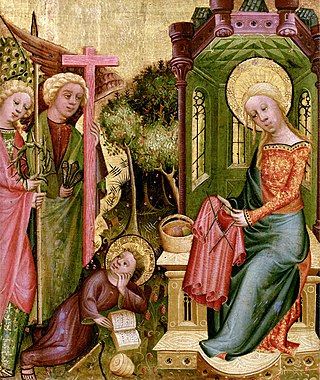
Knitting is the process of using two or more needles to pull and loop yarn into a series of interconnected loops in order to create a finished garment or some other type of fabric. The word is derived from knot, thought to originate from the Dutch verb knutten, which is similar to the Old English cnyttan, "to knot". Its origins lie in the basic human need for clothing for protection against the elements. More recently, hand knitting has become less a necessary skill and more of a hobby.

Fair Isle (/fɛəraɪ̯l/) is a traditional knitting technique used to create patterns with multiple colours. It is named after Fair Isle, one of the Shetland Islands. Fair Isle knitting gained considerable popularity when the Prince of Wales wore Fair Isle jumpers in public in 1921. Traditional Fair Isle patterns have a limited palette of five or so colours, use only two colours per row, are worked in the round, and limit the length of a run of any particular colour.
Intarsia is a knitting technique used to create patterns with multiple colours. As with the woodworking technique of the same name, fields of different colours and materials appear to be inlaid in one another, fit together like a jigsaw puzzle.
The term "gauge" is used in knitting to describe the fineness size of knitting machines. It is used in both hand knitting and machine knitting. The phrase in both instances refers to the number of stitches per inch rather than the size of the finished article of clothing. The gauge is calculated by counting the stitches or needles across a number of inches, then dividing by the sample's width in inches.
Combined knitting or combination knitting is a knitting method that combines elements of Eastern-style knitting with the Western techniques. The name was suggested by Mary Thomas in her 1938 book "Mary Thomas's Knitting Book", where she described the method as "..the better way to work in Flat Knitting. The resulting fabric is more even and closer in construction." By wrapping the yarn the opposite way while purling, the knitter changes the orientation of the resulting loops; then the next row's knit stitches can be formed by inserting the needle through the back leg, rather than through the front leg, without twisting the stitch. This method is suitable for all knitted fabrics from the basic Stockinette stitch, to any other technique, such as Fair Isle, circular knitting, or lace knitting.

A knitting machine is a device used to create knitted fabrics in a semi or fully automated fashion. There are numerous types of knitting machines, ranging from simple spool or board templates with no moving parts to highly complex mechanisms controlled by electronics. All, however, produce various types of knitted fabrics, usually either flat or tubular, and of varying degrees of complexity. Pattern stitches can be selected by hand manipulation of the needles, push-buttons and dials, mechanical punch cards, or electronic pattern reading devices and computers.
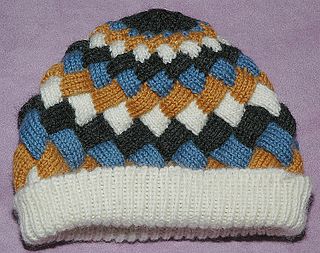
Entrelac is a knitting technique used to create a textured diamond pattern. While the result resembles basket-woven strips of knitted fabric, the actual material comprises interconnected squares on two different orientations.
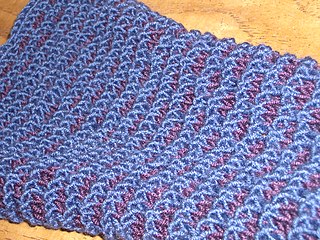
Slip-stitch knitting is a family of knitting techniques that uses slip stitches to make multiple fabrics simultaneously, to make extra-long stitches, and/or to carry over colors from an earlier row.

In knitting, an increase is the creation of one or more new stitches, which may be done by various methods that create distinctive effects in the fabric. Most knitting increases either lean towards the left or the right.
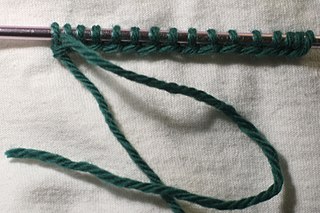
In knitting, casting on is a family of techniques for adding new stitches that do not depend on earlier stitches, i.e., having an independent lower edge. In principle, it is the opposite of binding off, but the techniques involved are generally unrelated.
In knitting, binding off, or casting off, is a family of techniques for ending a column of stitches. Binding off is typically used to define the final edge of a knitted fabric, although it may also be used in other contexts, e.g., in making button holes. In principle, binding off is the opposite of casting on, but the techniques are generally not mirror images of one another. Sometimes, however, they can produce a mirror image appearance.

Brioche knitting is a family of knitting patterns involving tucked stitches, i.e., yarn overs that are knitted together with a slipped stitch from the previous row. Such stitches may also be made by knitting into the row below and dropping the stitch above.
Basic knitted fabrics include stocking stitch, reverse stocking stitch, garter stitch, seed stitch, faggoting, and tricot. In some cases, these fabrics appear differently on the right side than on the wrong side.

Double knitting is a form of hand knitting in which two fabrics are knitted simultaneously on one pair of needles. The fabrics may be inseparable, as in interlock knitted fabrics, or they can simply be two unconnected fabrics. In principle, an arbitrary number of fabrics can be knitted simultaneously on one pair of knitting needles with yarns, as long as one is careful.

Knitted fabric is a textile that results from knitting, the process of inter-looping of yarns or inter-meshing of loops. Its properties are distinct from woven fabric in that it is more flexible and can be more readily constructed into smaller pieces, making it ideal for socks and hats.
Hand knitting is a form of knitting, in which the knitted fabric is produced by hand using needles.
A knitting pattern is a set of written instructions on how to construct items using knitting.

Twined knitting is a traditional Scandinavian knitting technique. It refers to knitting where two strands of yarn are knitted into the fabric alternatively and twisted once and always in the same direction before every stitch. The technique is called tvåändsstickning in Swedish, tvebandsstrikking in Norwegian, and tvebinding in Danish. Their literal meaning is "two-end knitting", referring to the traditional way of knitting with both yarn ends from one ball of yarn.






